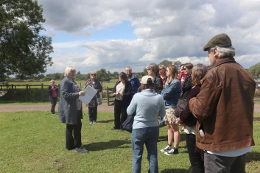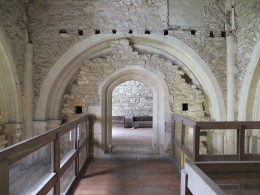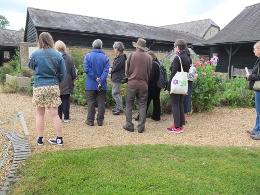

Saturday 15th June 2019 Return to Alumni Events

First refreshment in the cafe!!

Introduction

Changes by the Countess of Pembroke. The arch, which comes from the ground floor,
is interrupted by a second storey as well as being filled in.
The latest of our Local Heritage visits came at the end of a very wet week which threatened to make it a very uncomfortable trip. Instead we were treated to a dry day made most fascinating by an inspirational guide, Helen. The English Heritage site contains a farmland museum, a reconstructed fen workers house (Walnut Tree House), a museum and an Abbey with a huge history written into it's architecture.
The area was certainly associated with human habitation during the Roman period as Roman pottery and coins have been found but the real interest begins with a Benedictine Abbey. Monks from Ely built a small church there in 1159 which was constructed in the shape of a cross with all arms being equal in length. Round-topped arches with scalloped patterns, typical of the period can still be seen in the church but although most of the original church is still available to see in part, extras like the small cloisters have been lost by alterations over the years.
In 1170, the Knights' Templar took over to make it into a place of rest for the older members. They finished the church and added pointed leaf decorations to the top of the pillars of the arches. However as the throne of England became more suspicious of the power the Templars wielded, the abbey was taken away from them in 1308 as part of a cross-country action to destroy the order.
The abbey remained in the ownership of Ely Cathedral until it was granted to the rich Mary de Valence, Countess of Pembroke, in 1327. She made huge changes to make it fit for an order of nuns known as the Poor Clares. The existing building was changed to be a residence for herself, dividing it internally with new floors, filling in arches and making new dividing walls. New windows and doors penetrate old arches and a brand new church was built onto the old abbey together with large cloisters, refectory and dormitories. When their benefactor died the original abbey was used as a residence for the abbesses.
In 1539 the abbey was closed by the order of Henry the Eighth as a consequence of his break with the Pope and the dissoluton of the monasteries. The nun's church and other buildings were destroyed and the stones used to make walls around the farmland. In 1544 it reverted to a succession of farmers who kept the abbey as a house, again making changes over the years with new windows, fireplace and chimney in particular. Interestingly the nun's refectory was saved by converting it into a barn and the tiled floor and the raised flooring for the tables still exists. Finally in 1947 ownership fell to the Ministry of Works then to English Heritage in 1984.
The Farmland Museum began in 1964 with a 4-year old boy, Craig Delanoy, who collected bits of pottery on his parent's farm in Haddenham and charged his friends to look to make money for charity. Gradually the collection grew into a whole barn as people donated old pieces of machinery and so on. The museum opened on certain days, again for charity, until it became too much of a venture for the family and it was moved to the Denny Abbey site. English Heritage have continued to collect and added the fenman's house, the 1940s shop as well as other country craft exhibits.
The day was much to short to see everything, even after fortifying with lunch in their tearoom. So we have to thank all those volunteers who made it possible, especially Helen our superb guide, and visit again!

The Farmland museum behind our guide as she explains how
the vegetable garden is used when schools visit.
Pictures by Helen and Terry Moore (Click on the pictures for larger versions)